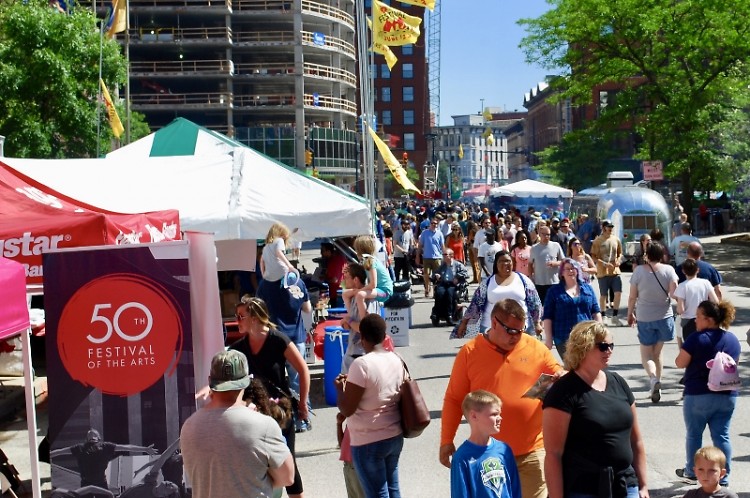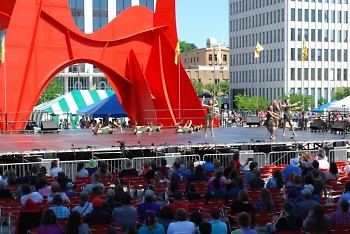Fifty years ago downtown Grand Rapids was in the midst of urban renewal.
In June 1969, in front of the new Grand Rapids City Hall, a massive work of abstract sculpture by American artist Alexander Calder titled “La Grande Vitesse” was installed on newly named Vandenberg Plaza.
With the help of Congressman Jerry Ford, later President Gerald R. Ford, the 43-foot tall, vibrant orange/red sculpture entered the history books as the first work public art funded in part by the fledgling National Endowment for the Arts.
One year later, to celebrate the first anniversary its installation, arts organizers in Grand Rapids launched a community celebration of the arts on the plaza near the 42-ton stabile.
Festival of the Arts, Grand Rapids’ signature celebration of arts and culture, celebrates its 50th anniversary over three days June 7-9.
Open to all for free, Festival continues to draw between 300,000 and 500,000 people each year to see live performances, view art, and sample ethnic food from food booths operated by churches, civic groups and art organizations.
Since its beginning, Festival has been run almost entirely by volunteers.
“My fondest memories are about our community coming together to make this amazing block-party happen,” recalled Kate Scheid Weber, co-chair of the 40th anniversary Festival 2009. “The level of dedication from all our volunteers is simply amazing.”
How Festival of the Arts began
In June 1970, with the downtown plaza finished and “The Calder” in place, the community was ready to celebrate. Organizers raised $15,000 from the Junior League, the Grand Rapids Foundation, and several other contributors.
A newly purchased portable stage was set up on Vandenberg Plaza along with a smaller stage on adjacent property near the former Old Kent Bank building. Art was hung on the exterior of City Hall on wire. Five booths served food. No city streets were closed and only $12,000 of the $15,000 raised was spent. But an estimated 7,000 people came for the very first Festival of the Arts.
“It was a success from the beginning,” said Dan Heines, co-chairman of the inaugural Festival of the Arts in 1970. “It was much smaller than it is today. It was pretty small but a whole lot of fun.”
The following year, Festival 1971 drew an estimated 30,000 people, operated 10 food booths, and erected a tent to display art. It wasn’t long before Festival of the Arts became a symbol of civic pride, recalled Buck Matthews, co-chair of Festival 1974.
“The community came to embrace it to such a degree that everything was possible,” Matthews recalled. “You had but to mention that Festival needed something, and Festival got it.”
Festival of the Arts takes shape
Over the years, familiar features of Festival of the Arts have endured, such as Paint-In and Mad Hatter for children to paint pictures or make hats. Poetry competitions, printmaking and silk screening T-shirts, and activities just for adults are familiar to regular Festival goers.
Since 1976, a highlight well in advance of Festival has been the unveiling of a specially commissioned poster by a local artist or artists to advertise the upcoming Festival of the Arts. The 50th anniversary poster created by renowned designer Stephen Frykholm was unveiled in April. Over the years, some posters have been controversial.
Eileen Schwarz-Duty and her Festival 1992 co-chair Simon Aguilar selected for their poster a photograph of the Calder stabile with a bolt of lightning behind it, photographed by Jim Starkey of The Grand Rapids Press. Some viewers found the image unsettling and even sinister.
“The good news is we sold every single copy of that most-controversial and talked-about poster,” Schwarz-Duty said with a laugh.
Opening ceremonies at noon on Friday have remained a constant at Festival, though specific events change from year to year. A launch of environmentally friendly balloons made of corn starch in 1996 was a big success. A planned pigeon launch in 1973 didn’t go as expected because the birds refused to leave their cages. In the end, they had to be tossed into the air one by one.
In 1986, co-chair Fred Bivins planned to participate in a hot-air balloon launch, but weather would not permit.
“The pilot who was slated to take us up said, ‘It’s better to be on the ground wishing you were up in the air then to be up in the air wishing you were on the ground,’” Bivins recalled.
It’s always warm and sunny at Festival. Except when it’s not
As an outdoor event held in late spring in Michigan, Festival of the Arts has enjoyed years of wonderful weather, years of terrible weather, and everything in between with temperatures varying from the 40s to the 90s.
The highest temperature recorded at Festival was 91 degrees on the Sunday of Festival 1990. The daily high temperatures at Festival 1971 reached 88 degrees and 89 degrees twice over three days.
At the other end of the spectrum, the highest temperature for the opening day of Festival 2012 only was 54 degrees. Festival 1975 was another among the coldest on record.
“I do remember that it was so cold, we were afraid it might snow,” recalled Karin Orr, co-chair of Festival 1975. “Coffee concessions did a bang-up business. Dove ice cream bars, not so much.”
A tornado warning during Festival 1980 sent everyone scurrying into to underground storm shelters. At Festival 1989, it rained all afternoon on Saturday beginning about 12 noon.
“The food booth folks stayed put. About 6 p.m. the sun came out and suddenly the streets were packed with people again,” recalled Terry Kuhn, co-chair of Festival 1989. “It was like a mini miracle.”
The weather on Saturday evening of Festival 2006 was so severe, it was the first time Festival was shut down entirely. But the event bounced back.
“We were a bit disheartened and disappointed,” recalled Festival 2006 co-chair Tim Pitcher. “However, we had confidence that the spirit of Festival would go on, and we concluded with a great day on Sunday. It’s just a huge testament to the astounding group of committees and volunteers that make Festival what it is and keep the machine moving.”
Festival of the Arts grows and evolves
Through the years, Festival of the Arts has evolved in ways large and small. Originally a part of the Arts Council of Greater Grand Rapids, Festival became its own 501c3 nonprofit organization in 2002. The Arts Council later closed, but Festival remains in business.
In 2018, Festival hired David Abbott as its first part-time executive director. But for its first 48 years, Festival was entirely operated by volunteers, who often gave up vacations or took time off work to make the three-day event happen.
“It did take two years out of my life but it was worth it,” recalled Sharon Yentsch, co-chair of Festival 1984. “I’ll never forget the sacrifices made by my two teenagers who gave up their only parent for those two years.”
Over the years, multiple generations of people not only have visited Festival, they’ve also volunteered their time to make the even happen. The list of nearly 100 Festival co-chairs includes many husbands and wives as well as parents and children.
Festival 2009 co-chair Tina Zinn, who attended the very first Festival, was raised alongside the event that was nominated in 1999 for inclusion in the U.S. Library of Congress’ Local Legacies Project. Congressman Vern Ehlers selected it as the event in his district that best represented the community.
“It was 1970, and I was 10,” Zinn recalled. “We'd just run around Festival. That's how I grew up around Festival.”
Festival 2004 co-chairs Shawn Bergsma and Stasia Savage were the youngest-ever co-chairs at the time and the start of a second generation of Festival leaders. The two shared master of ceremonies duties on Calder Stage on the Sunday morning of Festival 2004.
“We had dance contests, told jokes, had props, and I’m sure it was rather politically incorrect at times,” Savage recalled. “But we had a blast.”
Festival of the Arts becomes near and dear to the people of Grand Rapids
Over the past 50 years, a generation that once participated in children’s activities themselves now brings their own children downtown for Festival each June. Cat Timermanis, co-chair of Festival 1986, said she sees many familiar faces year after year.
“Festival to me is about connecting with people and creating a family atmosphere for an hour or two,” Timermanis said.
Baird Hawkins, co-chair of Festival 1994, remembers a single mother of three small children with limited means who looked forward to Festival every year because it was free.
“She told me how important it was to her and her children,” Hawkins said. “That really touched me and reminded me that Festival is truly a community event for everyone.
Becky Richard, co-chair of Festival 2016, said she’ll never forget singing on stage with a group called Guitars for Vets, a group of veterans, all of whom were beginning guitar players.
“As I stood there singing patriotic songs with these veterans, many who were in wheelchairs, who had given so much, I was deeply moved,” Richard recalled.
Festival still is free, fun and all about families
Over the years, entire families have been involved in capacities such as setting up Festival and taking it down or operating food booth that serve thousands of festival goers. Others have formed lifelong friendship through the shared experience of rolling barrels, putting up tents, silk screening flags, grilling food and passing out programs.
“I’m aware of how important the community of friends that is built through the many, many hours spent planning, defining, building, and executing a task of this scope,” said Mark Azkoul, co-chair of Festival 1993. “But the friendships and relationships that are created last long after the event.”
As Grand Rapids and West Michigan has grown and prospered over the past half century, arts and culture and entertainment have grown and expanded as well. Residents and visitors have more choices and more opportunities to fill their leisure time than ever before.
“I don't think they can say they have this kind of a connection with the people that live in this community,” said Lisa Radeck, co-chair of Festival 2017. “I think Festival of the Arts is truly a local event. That’s to say more West Michigan residents attend year after year, and that is one of the things that is special about Festival.”
A member of the Festival of Arts Board of Directors since 2017, Jeffrey Kaczmarczyk formerly was an arts and entertainment writer for The Grand Rapids Press and MLive, where he reported on Festival of the Arts for 23 years from 1993 to 2015.
The Rapidian, a program of the 501(c)3 nonprofit Community Media Center, relies on the community’s support to help cover the cost of training reporters and publishing content.
We need your help.
If each of our readers and content creators who values this community platform help support its creation and maintenance, The Rapidian can continue to educate and facilitate a conversation around issues for years to come.
Please support The Rapidian and make a contribution today.


